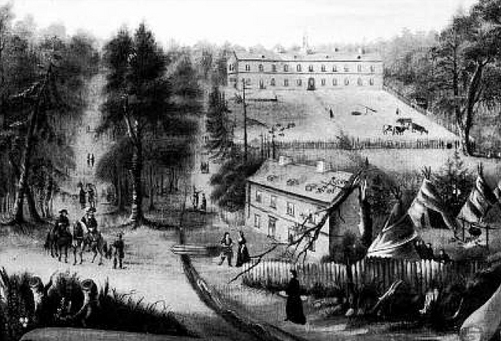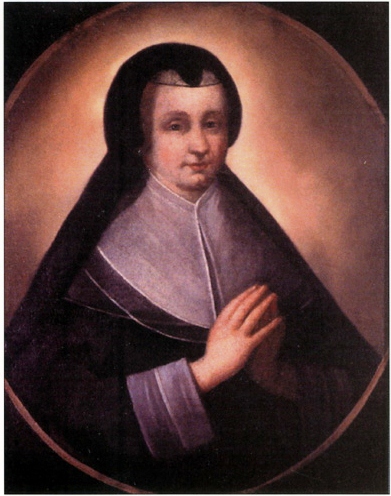In 1637, a year before the building of Harvard College, the Jesuits began a wooden structure in the rear of the fort [at Quebec]; and here, within one enclosure, was the Huron seminary and the college for French boys.
Meanwhile the female children of both races [French and Indian] were without instructors; but a remedy was at hand. At Alençon, in 1603, was born Marie Madeleine de Chauvigny, a scion of the haute noblesse of Normandy. Seventeen years later she was a young lady, abundantly wilful and superabundantly enthusiastic—one who, in other circumstances, might perhaps have made a romantic elopement and a mésalliance. But her impressible and ardent nature was absorbed in other objects. Religion and its ministers possessed her wholly, and all her enthusiasm was spent on works of charity and devotion. Her father, passionately fond of her, resisted her inclination for the cloister, and sought to wean her back to the world; but she escaped from the chateau to a neighboring convent, where she resolved to remain. Her father followed, carried her home, and engaged her in a round of fêtes and hunting parties, in the midst of which she found herself surprised into a betrothal to M. de la Peltrie, a young gentleman of rank and character. The marriage proved a happy one, and Madame de la Peltrie, with an excellent grace, bore her part in the world she had wished to renounce. After a union of five years, her husband died, and she was left a widow and childless at the age of twenty-two. She returned to the religious ardors of her girlhood, again gave all her thoughts to devotion and charity, and again resolved to be a nun. She had heard of Canada; and when [Fr.] Le Jeune’s first Relations appeared, she read them with avidity. “Alas!” wrote the Father, “is there no charitable and virtuous lady who will come to this country to gather up the blood of Christ, by teaching His word to the little Indian girls?” His appeal found a prompt and vehement response from the breast of Madame de la Peltrie. Thenceforth she thought of nothing but Canada. In the midst of her zeal, a fever seized her. The physicians despaired; but at the height of the disease the patient made a vow to St. Joseph, that, should God restore her to health, she would build a house in honor of Him in Canada, and give her life and her wealth to the instruction of Indian girls. On the following morning, say her biographers, the fever had left her. . . .

The first Ursuline Convent was built in 1642. This retrospective view was painted by Joseph Légaré (courtesy Ursuline Convent).
On the fourth of May, 1639, Madame de la Peltrie, Marie de l’Incarnation, Marie de St. Bernard, and another Ursuline embarked at Dieppe for Canada. . . .
They arrived at Tadoussac on the fifteenth of July; and the nuns ascended to Quebec in a small craft deeply laden with salted codfish, on which, uncooked, they subsisted until the first of August, when they reached their destination. Cannon roared welcome from the fort and batteries; all labor ceased; the storehouses were closed; and the zealous Montmagny [M. Charles de Montmagny, Governor of New France], with a train of priests and soldiers, met the newcomers at the landing. All the nuns fell prostrate, and kissed the sacred soil of Canada. They heard mass at the church, dined at the fort, and presently set forth to visit the new settlement of Sillery, four miles above Quebec.
Francis Parkman, The Jesuits in North America in the Seventeenth Century (Boston: Little, Brown, and Company, 1897, 1:260–62, 274–75.
Short Stories on Honor, Chivalry, and the World of Nobility—no. 842








